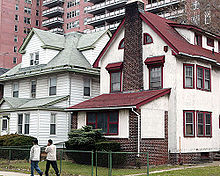 Kensington is a neighborhood in the center of the New York City borough of Brooklyn. It is the area south of Prospect Park and the Green-Wood Cemetery. It is bordered by Coney Island Avenue to the east, Caton Avenue/ Ft. Hamilton Parkway to the north, Dahill Road and 36th St to the west, and Foster Avenue and 47th Street to the south. The neighborhoods that border it are Ditmas Park and Prospect Park South to the east (both of which are parts of Flatbush), Windsor Terrace to the north, Borough Park to the west, and Midwood to the south.
Kensington is a neighborhood in the center of the New York City borough of Brooklyn. It is the area south of Prospect Park and the Green-Wood Cemetery. It is bordered by Coney Island Avenue to the east, Caton Avenue/ Ft. Hamilton Parkway to the north, Dahill Road and 36th St to the west, and Foster Avenue and 47th Street to the south. The neighborhoods that border it are Ditmas Park and Prospect Park South to the east (both of which are parts of Flatbush), Windsor Terrace to the north, Borough Park to the west, and Midwood to the south.
Kensington is a predominantly residential area consisting of housing types that run the gamut from brick rowhouses, to detached one family Victorians and apartment buildings. Pre-war brick apartment buildings dominate the Ocean Parkway and Coney Island Avenue frontage, many operating as co-ops. The main commercial streets are on Coney Island Avenue, Church Avenue, and Ditmas Avenue. Ocean Parkway bisects the neighborhood. Kensington is patrolled by the NYPD’s 66th Precinct.
Kensington is a very diverse neighborhood, containing Ukrainian, South Asian (Bangladeshi and Pakistani), Chinese, Orthodox Jewish, Hasidim, Irish, Polish, Italian, Albanian, Russian, Latino, Mexican, and Caribbean communities.
HISTORY
Kensington, originally colonized by Dutch farmers, was settled in 1737. Developed in 1885 after the completion of Ocean Parkway, the neighborhood was named after the place and borough in West London, at the turn of the century.
Ocean Parkway, which starts in Kensington, was finished in 1880; it features five miles of landscaped malls, benches, chess tables and walking and biking paths, linking Prospect Park to Coney Island, and is now part of the Brooklyn-Queens Greenway. Homebuilding began in earnest in the 1920s and attracted Italian and Irish immigrants to the neighborhood. Brick and brownstone townhouses coexist with single-and two-family homes with yards and garages. Five- and six-story pre- and post-war apartment buildings and co-ops are also common.
